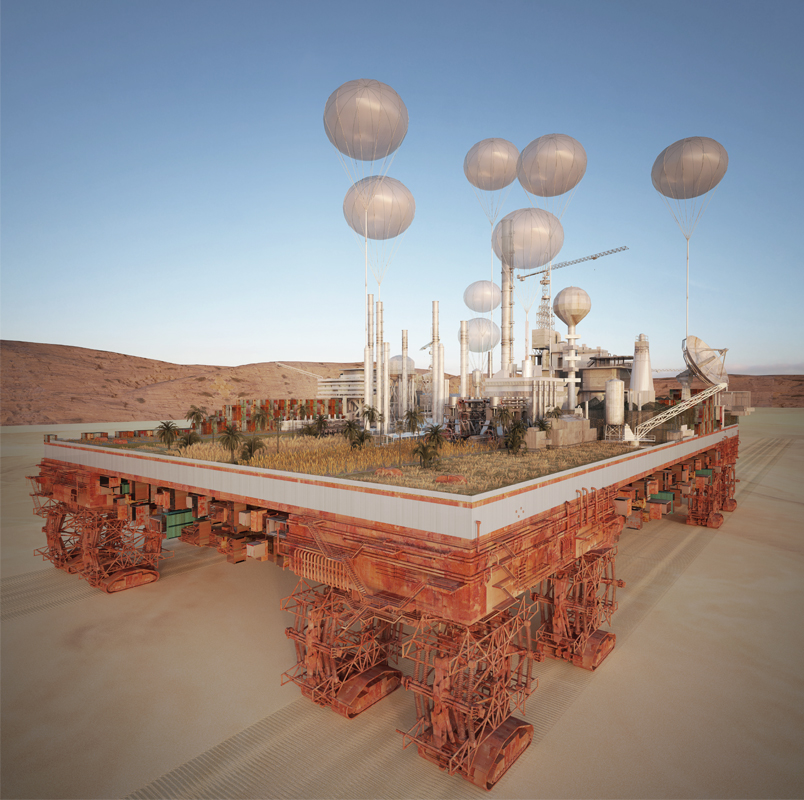THE GREEN MACHINE
VENICE BIENNIALE ARCHITETTURA 2014 – MOROCCAN PAVILION
SPECIAL MENTION FROM THE JURY
GREENING THE DESERT
Commissioned for the Venice Architecture Biennale in 2014, The Green Machine is a mobile oasis, designed to green the desert.
With the horizon in constant view, the desert fascinates with the magnificence of its landscapes and the purity of its lines. Beyond the silence and the visual appeal of this sublime landscape of absence, the desert is a territory rich in untapped resources. The potential influence of the desert on the surface of the globe is considerable; there are over fifteen million square miles of uncultivated desert land.
Seen through the prism of world overpopulation and global warming, the desert is a potential ally in terms of sustainability and human development. Every year, forty-six thousand square miles of land, equivalent to the size of Benin, is lost because of desertification and degradation.
These territories could produce twenty million tons of cereal a year. The desertification of these lands creates famine, decreases food safety, and contributes to poverty in the region, damaging the economic stability of nomadic and farming communities.
Poor land means poor people, political problems, and social unrest. Agriculture represents a fundamental building block of civilization; when biodiversity is lost, the entire social system goes bankrupt.
In 2007, the United Nations decreed desertification as one of the major issues of the twenty-first century. Indeed, territories and desert regions represent more than forty percent of the earth’s surface, and sixty percent of earth meadows are becoming depopulated.
The stakes in the Sahara Desert are regional, but also global. When the latter are damaged, they release carbon into the atmosphere. The desert moves forward only when naked grounds are not covered, even slightly, with plants. Saharan grounds are directly subjected to strong climatic variations, hot until dusk and freezing at night until dawn. A simple vegetable litter would temper these ravaging variations on the ground level to modify the microclimate, and thus give one more large scale to the microclimatic land.
Thanks to holistic management and strategically placed grassland, it is possible to regenerate dry and semi-dry ground, beginning with the Saharan border and existing oases. Given that only twenty percent of the Saharan surface is a sand desert, the range of possibilities is wide. Joining this axis, the mobile Green Machine oasis is a platform—a nomadic and autonomous agricultural and industrial city of regeneration of deficient ecosystems and development of the permaculture. It’s an ark of protection.
The structural slab of the city rose on four Caterpillar Crawlers, originally designed to carry NASA rockets from the manufacturing plant to the launching pad, and which can be driven with a considerable load on any type of ground.
The mobile oasis takes advantage of the hostile elements of the Saharan desert; the powerful sun and winds and great differences between daytime and nighttime temperatures.
The Green Machine is autonomous in its use of power, and actually generates electricity and produces water.
The Green Machine oasis is equipped with low-tech systems such as:
* Nine floating balloons which produce 450m3 of water daily from air condensation have the capacity to collect drinkable water from the air. The balloons collect steam from the air and liquefies it via condensation, to make it circulate in the vertical pipes to a reservoir placed on the slab. The same balloons are equipped with turbines which generate some renewable energy.
* Nine solar towers which produce 450 kilowatts of power every day.
* Twenty-four fields of wheat, five-thousand square feet each, directly transformed in factories dedicated to the Saharan seeding.
* Four hydroponic agricultural greenhouses, each five thousand square feet.
* Four 700m3 gallon water tanks.
* Livestock breeding and farms feed the inhabitants and fertilize the earth, inhabitants are fed and the local population are supplemented. Solid and liquid organic waste (after methanization and composting), fermentable waste, and waste water are recycled in a short local loop.
* Housing, schools, restaurants, places of relaxation, and pleasure gardens are included in the city.
* A retention pond of 50,000m3.
The principle of revitalization of lands is simple and has already begun; thanks to the tilling of the earth by the Caterpillars, furrows were formed. The first pairs of Caterpillars allow a first ploughing on which is poured a contribution of water to move the earth and rock is mixed in the sand. Then, the next pair of Caterpillars inject a mixture of water, natural fertilizer, and cereal seeds. The ground is ready to absorb and to retain the water by storing the carbon and by destroying the methane.
On a longer timescale, the biodiversity develops:
* One year after a field is left uncultivated, it is colonized by seasonal plants that last for a year. Wildlife is limited to insects and small animals which pass by looking for seeds.
* Five years later, some shrubs and long-lasting herbaceous plants appear, but most of the plants are still short-lived. Also found are termite mounds and rodent dens.
* In ten years, long-lasting weeds are present and trees begin to grow. Jackals and hares hide among shrubs. Finally, the old field distinguishes itself as more than an oasis, and many sorts of plants and animals are present. According to Allan Savory, researcher and developer of holistic farming techniques, if we could re-green half of the desert borders and the meadows of the world, the carbon preserved in the land would allow us to return to the environmental state of the preindustrial era,while feeding all of humanity.
- State: Experimental Architecture
- Year: 2014
- City: SAHARA
- Client: PAVILLON MAROCAIN FADA’ / BIENNALE DE VENISE 2014
- Team: Studio Malka, Yachar Bouhaya Architecte, Tristan Spella Render





















